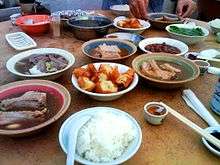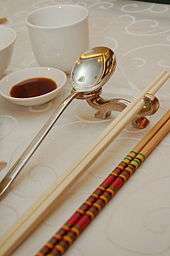Customs and etiquette in Chinese dining
 |
| This article is part of the series |
| Chinese cuisine |
|---|
|
Regional cuisines
|
|
Ingredients and types of food |
|
|
Customs and etiquette in Chinese dining are the traditional behaviors observed while eating in Greater China. Traditional Han customs have spread throughout East Asia, but sometimes evolved differently – especially following the Communist revolution that produced the PRC. Even within Mainland China, there are many customs and protocols involved in formal dining, applying to almost all aspects of the experience, from guest seating to paying the bill.
Table and place settings

In most traditional Chinese dining, dishes are shared communally. Although both square and rectangular tables are used for small groups of people, round tables are preferred for large groups, particularly in restaurants, in order to permit easy sharing. Lazy Susan turntables at are a common feature at the center of larger tables, to facilitate passing of serving dishes. A basic place-setting consists of a small teacup; a large plate with a small, empty rice bowl; a set of chopsticks, usually on the right of the plate; and a spoon. Additions may include a chopstick holder; a large water or wine glass; and a smaller glass for baijiu. At homes and low-end restaurants, napkins may consist of tissues or occasionally must to be provided by the diner. High restaurants often provide cloth napkins similar to western dining as part of the place-settings.
Formal seating order
There is a specific seating order to every formal dinner, based on seniority and organizational hierarchy. The seat of honor, reserved for the guest with the highest status or a foreign guest of honor, is usually the one in the center facing east or facing the entrance. Others with higher status then sit in close proximity to the seat of honor, while those with lower positions sit further away. The host takes the least prominent seat, generally the one nearest the kitchen entrance or service door.[1]
Courses

Wide variations exist throughout China, but the vast majority of full-course dinners are very similar in terms of timing and dishes.
Snacks
Snacks are the first items presented. Two or more small dishes are brought to the table, holding boiled unsalted peanuts, salted roasted peanuts, or similar dishes. These may be consumed while ordering, or while waiting for other dishes to arrive.
Beverages
Tea is almost always provided, either in advance of the diners being seated or immediately afterward. It can be consumed at leisure throughout the meal. (Water is sometimes served, but tea is the default beverage.) A verbal "thank you" (谢谢; xiexie) may be offered to the server pouring the refill or, if in the middle of a conversation where it would be rude to interrupt the speaker, the table may be tapped twice with two bent fingers instead.
Main course
This typically consists of many dishes, usually roughly one dish per person. White rice is provided in small bowls and food is often consumed over it, flavoring it with their sauces. The rice is consumed little by little along with the other dishes and not separately, unless the diner remains hungry after the last dish has been removed.
A soup may also be served as one of the dishes. At small meals, especially at home, it may replace the diners' beverage entirely.
Starch
Near the end of the meal, a starch dish – noodles, Chinese dumplings, or baozi – is sometimes served, to ensure that guests are satiated.
Manners and customs
Eating is a dominant aspect of Chinese culture, and eating out is one of the most common ways to honor guests, socialize, and deepen friendships.[2]
Proper etiquette is very important to traditional Chinese people, who feel good manners invite luck, and boorish conduct brings shame. Although many Maoist programs aimed to curtail traditional social practices, today table etiquette is again taken as an indication of educational status, so that (for example) a child misusing their chopsticks at a formal dinner might embarrass their family, who are responsible for teaching the child.[2][3]
Inviting guests
Although individual households may have their own house rules, the Chinese traditions used to welcome guests are largely the same throughout the country.[4][5] There are common rules for inviting guests over.[3][5][6]
Dining
Drinking
Water and other non-alcoholic beverages may be consumed at any time. However, in formal settings, alcohol should be consumed during toasts. A modest toast may be followed by a single sip of wine or swallow of beer, but a baijiu toast is often ended with Ganbei! (干杯): an exhortation to drain the glass. Ideally, glasses are refilled immediately following a toast in preparation for the next.
Lazy Susan

A Lazy Susan is a circular rotating tray placed at the center of a table and used to easily share a large number of dishes among the diners. A Lazy Susan can be made from many materials, but most often they are constructed of glass, wood, or plastic.
It is typical for all the dishes for a course to be brought out together and placed around the Lazy Susan. If the dishes come out one at a time or if there is some special delicacy, they are typically served to the guest of honor first and then rotated clockwise around the table. The host will often wait to serve himself last. Dishes should typically not be removed from the Lazy Susan and placed on the table: at most, one should hold the dish aloft while serving and then return it to its place on the tray.
One should try to avoid moving the Lazy Susan even slightly when someone is in the act of transferring food from the dishes to their plate or bowl. Likewise, it is impolite to hoard or use up all of a dish until it has been offered to everyone and the other diners clearly do not care for it. For this reason, it is common to take a smaller amount from the dishes on the first round and to keep the other diners in mind when taking a larger second helping.
Personal
Since chopsticks (and spoons) are used in place of forks and knives, Chinese cuisine tends to serve dishes in bite-size pieces or employ cooking techniques that render dishes such as fish or hong shao rou soft enough to be picked apart easily.[7] Some common etiquette is:[5][6][8]
- Chopsticks should always be the same length and held so that the ends are even, a practice popularly explained as due to the former use of uneven boards (三長兩短) in Chinese coffins.
- Similarly, do not leave chopsticks sticking upright out of dishes, owing to a Chinese practice of leaving such dishes for the dead, and visual similarity to burning incense for the dead.
- Do not chew on the ends of chopsticks, even if they are plastic.
- Chopsticks are not used to move bowls or plates.
- Do not bang your chopsticks as though you were playing a drum. It implies you are a beggar or a child.
- Treat chopsticks as extension of your fingers. It is impolite to use them to point at other people or to wave chopsticks around.
- Unless they are disposable, chopsticks will be washed and reused. Consequently, don't use them to pick at your teeth or for other unseemly endeavors.
- Avoid spearing food with the chopsticks.
- One should not 'dig' or 'search' through one's food for something in particular. This is sometimes known as "digging one's grave" or "grave-digging" and is extremely poor manners.
- When not in use, and if the restaurant provides them, place the front end of the chopsticks on the chopstick rests. These are usually small ceramic rests placed near your napkin on the right hand side of your bowl.
- Both hands should be above the table even when the left hand is not holding a utensil. For right-handed people who hold chopsticks in their right hand, their left hands either hold down the bowl on the table, or pick it up so that it is near the mouth. It is considered rude to leave the left hands on their laps, although exceptions are sometimes made when eating from a plate.
Communal

At most formal meals, there are likely pairs of communal serving chopsticks (公筷, gongkuai). These are sets of chopsticks specifically for shared dishes only. Often, these will be distinct from the putongkuai (regular chopsticks) in that they will be longer and more ornate. There will sometimes be one set of communal chopsticks per dish or one set per course. The ratio varies.[9]
Bill
In most restaurants in Chinese countries, there is no tip required unless it is explicitly posted. Usually, if there is a tip required, it will already be on your bill. In Chinese restaurants in the USA though, tips are usually expected.
See also
References
- ↑ http://www.internations.org/hong-kong-expats/guide/15908-culture-shopping-recreation/dining-in-hong-kong-etiquette-15914
- 1 2 Dobsons, Richard. China Cycle, p. 20. 2006. 8 Feb 2010.
- 1 2 Chai, May-Lee & al. China A to Z, p. 104. Plume Books (New York), 2007.
- ↑ Morse, Edward. Glimpses of China and Chinese Homes, p. 65. Kegan Paul, Int'l (New York), 2001.
- 1 2 3 Hu Wenzhong & al. Encountering the Chinese: A Guide for Americans, pp. 35–40. 1999. Accessed 21 Jan 2010.
- 1 2 Zhou, Cathy. Chinese Etiquette and Culture, p. 26. 2005. Accessed 21 Jan 2010.
- ↑ Inness, Sherrie. "Home Cooking ." Kitchen Culture in America: Popular Representations of Food, Gender, and Race (2001): 14. Web. 21 Jan 2010. <https://books.google.com/books?id=Ik7w8jQhzHMC&pg=RA4-PA14&dq=chinese+table+etiquette&lr=&ei=7flXS7G0IaaolQTd3rCwAw&cd=31#v=onepage&q=chinese%20table%20etiquette&f=false>.
- ↑ Fox, Sue. "Chapter 19: On the Go: Travel Manners for Land, Sea, and Air ." Etiquette for Dummies (2007): 319. Web. 21 Jan 2010. <https://books.google.com/books?id=HGno_t1crwwC&pg=PA319&dq=Dining+Etiquette+china&lr=&cd=34#v=onepage&q=Dining%20Etiquette%20china&f=false>.
- ↑ 91011 12